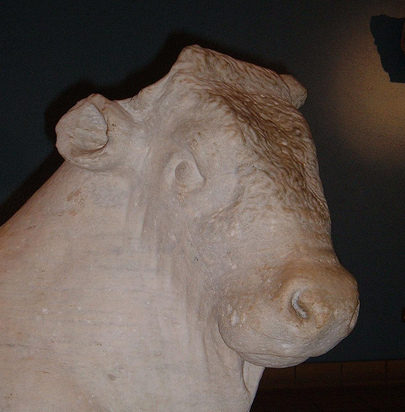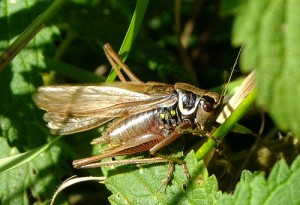Following on from my write-up of grasshoppers I’ve seen in Sandy, I would like to do the same for their close-relatives, bush-crickets. Bush-crickets are also orthoptera, but I find them more interesting. They are generally shorter but more bulky, larger, and have really long antennae, hence their old-fashioned name: long-horned grasshoppers; in America I believe they are also known as katydids. They are a lot easier to identify than grasshoppers: colours tend to be more consistent, although most of them seem to be green, but the females in particular have long ovipositors at the back whose shape tends to give the species away. Some of them tend to hang around on tops of leaves if you keep your eyes open- especially dark bush-crickets and speckled bush-crickets- and some have repetitive (dark bush-cricket) or long (roesel’s bush-cricket) songs which helps in tracking them down. Some of them have been living in our garden for years, which helps. All these photos were taken in Sandy, several in our garden.
Dark bush-cricket (Pholidoptera griseoaptera)
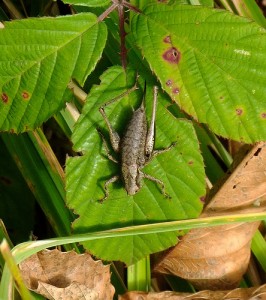

The dark bush-cricket is commonly found on brambles, sometimes sitting on top of the leaves. Their song is quite distinctive: a short repeated buzz. I once went for a run at twilight past about 100 yards of brambles. I’ve never seen any there and couldn’t see any then as it was too dark but I heard loads all the way along. The male and female look quite different. Only the male sings and so is the only one with any wings to speak of, although these are hardly there either. The female has a clear long and curved ovipositor.
More on this at the Orthoptera & Allied Insects site and Wikipedia.
Speckled bush-cricket (Leptophyes punctatissima)

Last year I managed to get loads of this as they’ve been active and breeding in the lavender in our garden (e.g. this one from above, this one shedding its skin, these two mating, and so on) but they weren’t around so much this year, presumably because of there being less sun. Like the dark bush-cricket, they are also found on brambles, and I’ve seen them together a few times. The picture above shows the wonderful crazy eyes bush-crickets have, especially when their antennae are going all over the place. They are also, as one might expect, speckled, although it’s not as obvious to the naked eye as it is on a photo. Although you can’t see it here, the ovipositor is sickle shaped. It does sing but its wings are so small they are barely audible without a bat detector.
More on this at the Orthoptera & Allied Insects site and Wikipedia.
Oak bush-cricket (Meconema thalassinum)
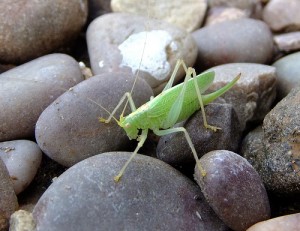
This one lives in trees, but I found it on a path near the health centre in Sandy. If you go near a bush-cricket, they normally jump away more violently than their awkward walking would suggest. This one though actually walked onto my hand like a ladybird would. It kept walking and was happy to keep walking over my hands and my coat. I was on my way to picking up my daughter from school and it stayed on my coat the whole way there, while I was waiting, and all the way home. I put it down on the pebbles in the back garden, where I got the above photo. It was so tame, it let me put it on the rosemary and, when I’d changed my mind, onto the apple tree where I thought it’d be happier. I haven’t seen it since though.
You can see it has a straighter ovipositor than the two above. Despite the larger wings, it doesn’t sing at all but (apparently) drums its foot on a leaf.
More on this at the Orthoptera & Allied Insects site and Wikipedia.
Long-winged conehead (Conocephalus discolor)

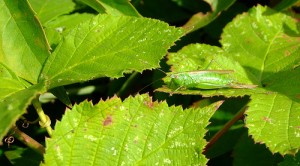
This is one I tracked down by sound on a patch of waste ground near the railway line. This is one example of an insect whose range has expanded hugely in recent years, presumably as a result of climate change. They have an excellent name, and there is indeed a short-winged conehead.* The ovipositor is almost straight.
More on this at the Orthoptera & Allied Insects site and Wikipedia.
Roesel’s bush-cricket (Metrioptera roeseli)
I sadly didn’t get any pictures of these this year although I saw a few and heard loads more. These are relatively easy to find as their song is a long aggressive buzzing, so you can home in on them quickly. They hide in long grass, though, so it’s hard to get a camera near them without a blade of grass getting in the way. They are also somewhat more jumpy than the oak bush-cricket mentioned above so if you get too close and alarm them they jump and disappear in a flash. However, here is one from 2011:
It looks a little like a dark bush-cricket at first glance although it has a distinctive pale U-shape behind the head. The female has a sharply curved ovipositor. They normally have shortish wings, but in good sunny years long-winged (macropterous) individuals appear and the one above is such a macropterous example. You can see and hear this singing in this dodgy video I took.
More on this at the Orthoptera & Allied Insects site and Wikipedia.
Hopefully next year there will be more sun, so there are more insects and more light for the camera!
* It has short wings.
